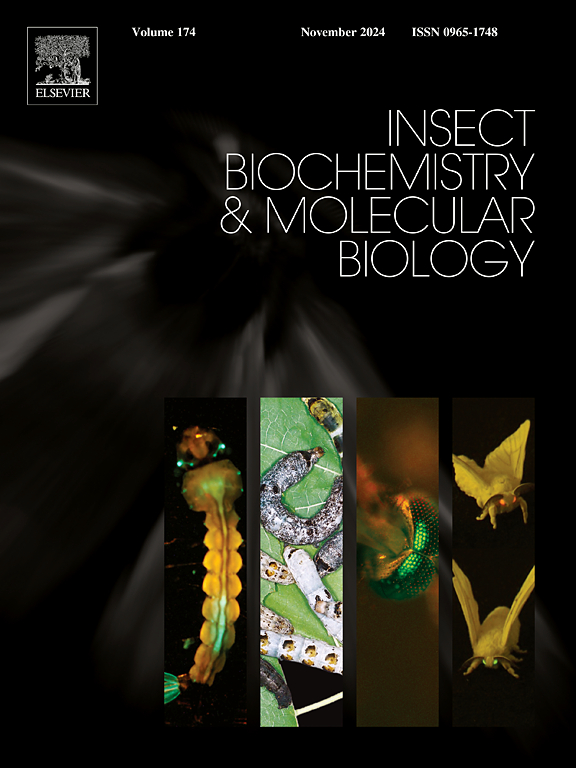Linear peptides from the venom of large marsh horsefly (Tabanus autumnalis) larvae facilitate prey capture and defense
IF 3.7
2区 农林科学
Q2 BIOCHEMISTRY & MOLECULAR BIOLOGY
引用次数: 0
Abstract
Venoms are complex cocktails containing novel biomolecules. Many venomous animal groups are understudied, including Horseflies of the family Tabanidae. Their larvae utilize venom to overpower prey and to defend against predators. Recent studies uncovered short linear peptides in their venoms but their bioactivity spectrum and biological function remain unknown. Here, we employ a bioactivity profiling of eight synthesized toxins of the large marsh horsefly (Tabanus autumnalis) larval venom via in silico, in vitro, and in vivo experiments. Bioinformatic analysis suggest, that the selected peptides fold into cationic and amphipathic alpha-helices. Assays against microbes reveal antimicrobial activity potentially via membrane interaction caused by some of the linear Tabanus toxins, while tests on vertebrate cells reveal cytotoxic and hemolytic effects. Lastly, injections of the peptides in Drosophila melanogaster flies recovered insecticidal and paralytic activity. Based on our analysis, we propose that some of the linear T. autumnalis peptides facilitate prey capture via their rapid paralytic activity in insects. A second line of functional utilization may be present in defense against predators and microbial colonization. From a translational perspective, it appears unlikely that the tested peptides could efficiently be translated into anti-infectives, while an evaluation for agricultural exploitation demands further research. Our study provides functional insights into the toxin repertoire of one of the least studied venom systems on earth and serves as starting point to further investigate dipteran venom biology.

从大型沼泽马蝇(Tabanus秋天)幼虫毒液中提取的线状肽有助于捕获猎物和防御。
毒液是含有新型生物分子的复杂混合物。许多有毒的动物群体都没有得到充分的研究,包括虻科的马蝇。它们的幼虫利用毒液压制猎物并抵御捕食者。最近的研究发现了它们毒液中的短线状肽,但其生物活性谱和生物学功能尚不清楚。在这里,我们通过硅、体外和体内实验对大沼泽马蝇(Tabanus autumn)幼虫毒液的八种合成毒素进行了生物活性分析。生物信息学分析表明,所选择的肽折叠成阳离子和两性的α -螺旋。对微生物的试验显示,抗菌活性可能是通过一些线性Tabanus毒素引起的膜相互作用,而对脊椎动物细胞的试验显示细胞毒性和溶血作用。最后,在黑腹果蝇中注射肽恢复了杀虫和麻痹活性。基于我们的分析,我们提出一些线性的秋蚜肽通过它们在昆虫体内的快速麻痹活动来促进猎物的捕获。第二种功能利用可能存在于防御捕食者和微生物定植。从转化的角度来看,所测试的肽似乎不太可能有效地转化为抗感染药物,而农业开发的评估需要进一步研究。我们的研究提供了对地球上研究最少的毒液系统之一的毒素库的功能见解,并作为进一步研究双翅目毒液生物学的起点。
本文章由计算机程序翻译,如有差异,请以英文原文为准。
求助全文
约1分钟内获得全文
求助全文
来源期刊
CiteScore
7.40
自引率
5.30%
发文量
105
审稿时长
40 days
期刊介绍:
This international journal publishes original contributions and mini-reviews in the fields of insect biochemistry and insect molecular biology. Main areas of interest are neurochemistry, hormone and pheromone biochemistry, enzymes and metabolism, hormone action and gene regulation, gene characterization and structure, pharmacology, immunology and cell and tissue culture. Papers on the biochemistry and molecular biology of other groups of arthropods are published if of general interest to the readership. Technique papers will be considered for publication if they significantly advance the field of insect biochemistry and molecular biology in the opinion of the Editors and Editorial Board.

 求助内容:
求助内容: 应助结果提醒方式:
应助结果提醒方式:


